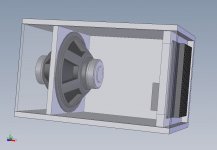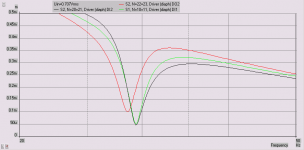Eh?Simply because the sound moves you like no other you can taste it.
2x8ohm = 4ohm and same output (as single 8ohm driver)He's saying it has good bass!
I've always liked the idea of half the box size, plus it's an interesting way to use two 4-Ohm drivers and get 8 Ohm load.
2x4ohm = 8ohm and minus 3 or 6db output?
Last edited:
Try and avoid using isobaric configuration in a ported enclosure. You won't get the same excursion-limited SPL as you would with a single driver, due to the enclosure resonance changing the effective rear enclosure volume.
See the attached graph, showing excursion.
The red line is the excursion of the outer driver of a clamshell pair.
The black line is the excursion of the inner driver.
The green line is the excursion of a single driver with T-S specs equal to the combined clamshell pair.
Most of the time, the volume of the rear enclosure is much larger than the volume of the space in the clamshell, so the two drivers move almost together.
But at port resonance, the back-pressure of the enclosure resonance has the same effect as making the enclosure much smaller, and the ratio of the two volumes becomes smaller. The volume of the clamshell space becomes significant.
See the attached graph, showing excursion.
The red line is the excursion of the outer driver of a clamshell pair.
The black line is the excursion of the inner driver.
The green line is the excursion of a single driver with T-S specs equal to the combined clamshell pair.
Most of the time, the volume of the rear enclosure is much larger than the volume of the space in the clamshell, so the two drivers move almost together.
But at port resonance, the back-pressure of the enclosure resonance has the same effect as making the enclosure much smaller, and the ratio of the two volumes becomes smaller. The volume of the clamshell space becomes significant.
Attachments
Last edited:
Is it best to create a slightly bigger volume between the two drivers?But at port resonance, the back-pressure of the enclosure resonance has the same effect as making the enclosure much smaller, and the ratio of the two volumes becomes smaller. The volume of the clamshell space becomes significant.
In my design concept, spl is not a biggie, as the mid I want to use kind of compromises ultimate output. All the same, this is very interesting and thanks for posting
The satori WO24p is available in both 4 and 8 ohm, so if I'm only losing 3db output from 2 in series, I might do it that way.
What ever the voltage sensitivity of the 4 ohm version is, if used in series as an isobaric, the voltage sensitivity would be reduced by 6dB. I'm sure that the sensitivity of the 4 and 8 ohm versions are different to start with.
Doesn't matter whether 4 or 8 ohms. You will always have 3dB lower efficiency for the isobaric compared to a single driver. But in parallel you double the power in (for a given voltage drive) and get the same SPL out where as in series you cut the power in by 1/2 and get 6dB lower SPL out.
If the 4 ohm driver is more efficient than the 8 ohm, that's something else to consider.
Ah ok, so if using the 4 ohm version rated at 91dB, i'd be looking at a 6 dB loss in output in series. For some reason I thought it was only a 3dB loss in output overall. Id better stick to the 88dB 8ohm drivers in parallel then.What ever the voltage sensitivity of the 4 ohm version is, if used in series as an isobaric, the voltage sensitivity would be reduced by 6dB. I'm sure that the sensitivity of the 4 and 8 ohm versions are different to start with.
Doesn't matter whether 4 or 8 ohms. You will always have 3dB lower efficiency for the isobaric compared to a single driver. But in parallel you double the power in (for a given voltage drive) and get the same SPL out where as in series you cut the power in by 1/2 and get 6dB lower SPL out.
If the 4 ohm driver is more efficient than the 8 ohm, that's something else to consider.
Last edited:
Is it best to create a slightly bigger volume between the two drivers? ...
Smaller is better. The ideal is to rigidly couple the cones, maybe by gluing a cardboard tube between the centres of the cones. I've tried, it's hard to do accurately - the tube has to be the exact length so as not to push the cones away from their rest position when the drivers are fastened together face to face. Remove the dust caps and choose a tube diameter that just fits over the voice coil former. Much easier to spend a little extra on a single better driver...
Wow that's a solution. Not sure i'd have the guts to try it tho.Mount the drivers on their common baffle, use 'fixtures' to keep the cones still, and then inject spray foam insulation in the isobar chamber, and just let dry. Boom!
Boom! No more surround movement, just one ridged laminate with a resonant frequency similar to a duck's quack, and the sensitivity of a stoneMount the drivers on their common baffle, use 'fixtures' to keep the cones still, and then inject spray foam insulation in the isobar chamber, and just let dry. Boom!

I purposefully left it to your imagination to figure out the step where you mask off the surrounds.
Fixing the cones together is not isobaric. It's making a driver with 2x mass, and depending on how you wire the VCs, parallel: 1/2 Re, same BL, 2x Rms, 1/2 Cms, or series: 2x Re, 2x BL, 2x Rms, 1/2 Cms. This NEW driver will have the same Fs, Qms, Qes, as the original drivers by 1/2 Vas and 1/2 the efficiency. It's basically what I said at the start. Rather than isobaric, just get a driver with the same Fs, and Qts and 1/2 the Vas.
Here is an interesting aside which shows just how stupid the isobaric idea was. The original idea was that by placing a second driver behind the front the rear driver would move like the front and the pressure in the isobaric chamber would be atmospheric and thus the front driver would behave as if mounted on an infinite baffle or free air. The idea was that it would extend bass response. Unfortunately the idea was flawed because, obviously, for the air in the isobaric chamber to remain at constant, atmospheric pressure, the rear driver would also have to move as if in free air which doesn't happen when you enclose it in a box.
... Unfortunately the idea was flawed because, obviously, for the air in the isobaric chamber to remain at constant, atmospheric pressure, the rear driver would also have to move as if in free air which doesn't happen when you enclose it in a box.
The pressure changes the front driver sees are only the errors in the rear driver's reproduction of the signal, not the whole signal. That's a big difference.
I still think the idea is cool. I might build one some day too, regardless of whether or not there are better approaches.
Cheers,
Jeff.
The pressure changes the front driver sees are only the errors in the rear driver's reproduction of the signal, not the whole signal. Cheers,
Jeff.
No, they are not. The pressure in the isobaric chamber varies as the pressure would vary if the front driver were mounted in a box twice the size of the rear box. Think about the mechanics. When you mount a driver in a box the trapped air pressure in the box is a force against which the driver moves. If the front driver in an isobaric system is to move with a similar motion the pressure in the isobaric chamber must vary in the same manner and with the same magnitude. Otherwise the alignment would be different. F=ma
The pressure changes the front driver sees are only the errors in the rear driver's reproduction of the signal, not the whole signal. That's a big difference.
I still think the idea is cool. I might build one some day too, regardless of whether or not there are better approaches.
Cheers,
Jeff.
I've tried clamshell isobaric and liked it a lot, and see no reason to avoid it for bass. But I see it as a way to use cheap woofers, ie use 4 $20 woofers to outperform one $80 woofer.
What is the origin of the difference/error in dispacement? How can it be minimized? Is {{ a better isobaric layout than {}? Is it from the woofer's geometry?
... What is the origin of the difference/error in dispacement? How can it be minimized? Is {{ a better isobaric layout than {}? Is it from the woofer's geometry?
The air between the drivers has compliance (is compressible). It can be mimimised by minimising the volume between the drivers. Clamshell ({}) usually results in a smaller volume than daisy chain ({ {).
- Status
- This old topic is closed. If you want to reopen this topic, contact a moderator using the "Report Post" button.
- Home
- Loudspeakers
- Multi-Way
- Isobaric frequency limits?

